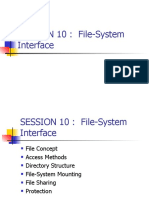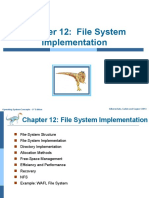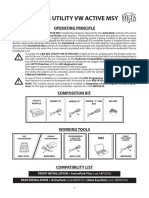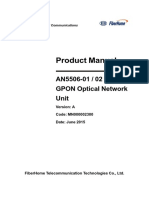L13 File System Interface
L13 File System Interface
Uploaded by
Neha GargCopyright:
Available Formats
L13 File System Interface
L13 File System Interface
Uploaded by
Neha GargOriginal Title
Copyright
Available Formats
Share this document
Did you find this document useful?
Is this content inappropriate?
Copyright:
Available Formats
L13 File System Interface
L13 File System Interface
Uploaded by
Neha GargCopyright:
Available Formats
File-System Interface
File-System Interface
File Concept
Access Methods
Directory Structure
File Sharing
Protection
AE4B33OSS 10.2 Silberschatz, Galvin and Gagne
File Concept
Contiguous logical address space
Types:
Data
numeric
character
binary
Program
AE4B33OSS 10.3 Silberschatz, Galvin and Gagne
File Structure
Sequence of words, bytes
Simple record structure
Lines
Fixed length
Variable length
AE4B33OSS 10.4 Silberschatz, Galvin and Gagne
File Attributes
Name – only information kept in human-readable form
Identifier – unique tag (number) identifies file within file
system
Type – needed for systems that support different types
Location – pointer to file location on device
Size – current file size
Protection – controls who can do reading, writing,
executing
Time, date, and user identification – data for protection,
security, and usage monitoring
Information about files are kept in the directory structure,
which is maintained on the disk
AE4B33OSS 10.5 Silberschatz, Galvin and Gagne
File Operations
File is an abstract data type
Create
Write
Read
Reposition within file
Delete
Truncate
Open(Fi) – search the directory structure on disk for entry
Fi, and move the content of entry to memory
Close (Fi) – move the content of entry Fi in memory to
directory structure on disk
AE4B33OSS 10.6 Silberschatz, Galvin and Gagne
File Types – Name, Extension
AE4B33OSS 10.7 Silberschatz, Galvin and Gagne
Access Methods
Sequential Access
read next
write next
reset
rewrite
Direct Access
read n
write n
position to n
read next
write next
rewrite n
n = relative block number
AE4B33OSS 10.8 Silberschatz, Galvin and Gagne
Sequential-access File
AE4B33OSS 10.9 Silberschatz, Galvin and Gagne
Simulation of Sequential Access on a Direct-
access File
AE4B33OSS 10.10 Silberschatz, Galvin and Gagne
Example of Index and Relative
Files
AE4B33OSS 10.11 Silberschatz, Galvin and Gagne
Directory Structure
A collection of nodes containing information about all files
Directory
Files
F1 F2 F4
F3
Fn
Both the directory structure and the files reside
on disk
AE4B33OSS 10.12 Silberschatz, Galvin and Gagne
A Typical File-system Organization
AE4B33OSS 10.13 Silberschatz, Galvin and Gagne
Operations Performed on Directory
Search for a file
Create a file
Delete a file
List a directory
Rename a file
Traverse the file system
AE4B33OSS 10.14 Silberschatz, Galvin and Gagne
Organize the Directory (Logically) to
Obtain
Efficiency – locating a file quickly
Naming – convenient to users
Two users can have same name for different
files
The same file can have several different names
Grouping – logical grouping of files by properties,
(e.g., all Java programs, all games, …)
AE4B33OSS 10.15 Silberschatz, Galvin and Gagne
Single-Level Directory
A single directory for all users
Naming problem
Grouping problem
AE4B33OSS 10.16 Silberschatz, Galvin and Gagne
Two-Level Directory
Separate directory for each user
Path name
Can have the same file name for different user
Efficient searching
AE4B33OSS 10.17 Silberschatz, Galvin and Gagne
Tree-Structured Directories
AE4B33OSS 10.18 Silberschatz, Galvin and Gagne
Tree-Structured Directories (Cont)
Efficient searching
Grouping Capability
Current directory (working directory)
cd /spell/mail/prog
type list
AE4B33OSS 10.19 Silberschatz, Galvin and Gagne
Tree-Structured Directories (Cont)
Absolute or relative path name
Creating a new file is done in current directory
Delete a file
rm <file-name>
Creating a new subdirectory is done in current
directory
mkdir <dir-name>
Example: if in current directory /mail
mkdir count
prog copy prt expcount
Deleting “mail” deleting the entire subtree rooted
by “mail”
AE4B33OSS 10.20 Silberschatz, Galvin and Gagne
Acyclic-Graph Directories
Have shared subdirectories and files
AE4B33OSS 10.21 Silberschatz, Galvin and Gagne
Acyclic-Graph Directories (Cont.)
Two different names (aliasing)
If dict deletes list dangling pointer
Solutions:
Backpointers, so we can delete all pointers
Variable size records a problem
Backpointers using a daisy chain organization
Entry-hold-count solution
New directory entry type
Link – another name (pointer) to an existing file
Resolve the link – follow pointer to locate the file
AE4B33OSS 10.22 Silberschatz, Galvin and Gagne
General Graph Directory
AE4B33OSS 10.23 Silberschatz, Galvin and Gagne
File Sharing
Sharing of files on multi-user systems is desirable
Sharing may be done through a protection scheme
On distributed systems, files may be shared across a
network
Network File System (NFS) is a common distributed file-
sharing method
AE4B33OSS 10.24 Silberschatz, Galvin and Gagne
File Sharing – Multiple Users
User IDs identify users, allowing permissions and
protections to be per-user
Group IDs allow users to be in groups, permitting
group access rights
AE4B33OSS 10.25 Silberschatz, Galvin and Gagne
File Sharing – Remote File Systems
Uses networking to allow file system access between
systems
Manually via programs like FTP
Automatically, seamlessly using distributed file systems
Semi automatically via the world wide web
Client-server model allows clients to mount remote file
systems from servers
Server can serve multiple clients
Client and user-on-client identification is insecure or
complicated
NFS is standard UNIX client-server file sharing protocol
CIFS is standard Windows protocol
Standard operating system file calls are translated into
remote calls
Distributed Information Systems (distributed naming services)
such as LDAP, DNS, NIS, Active Directory implement unified
access to information needed for remote computing
AE4B33OSS 10.26 Silberschatz, Galvin and Gagne
Protection
File owner/creator should be able to control:
what can be done
by whom
Types of access
Read
Write
Execute
Append
Delete
List
AE4B33OSS 10.27 Silberschatz, Galvin and Gagne
Access Lists and Groups
Mode of access: read, write, execute
Three classes of users
RWX
a) owner access 7 111
RWX
b) group access 6 110
RWX
c) public access 1 001
Ask manager to create a group (unique name), say G, and
add some users to the group.
For a particular file (say game) or subdirectory, define an
appropriate access.
owner group public
chmod 761 game
Attach a group to a file
chgrp G game
AE4B33OSS 10.28 Silberschatz, Galvin and Gagne
You might also like
- H.K. A-Z Kali Linux Commands - Also Included Kali Commands PDF - 4f4c69c4Document28 pagesH.K. A-Z Kali Linux Commands - Also Included Kali Commands PDF - 4f4c69c4Orión Brady0% (1)
- (DING - COM) HOW TO CASHOUT Gift Card WCCDocument2 pages(DING - COM) HOW TO CASHOUT Gift Card WCCcody100% (2)
- NP2013082217EN 1830 VWM DWDM R6.0 Datasheet PDFDocument3 pagesNP2013082217EN 1830 VWM DWDM R6.0 Datasheet PDFplinio_de_paulaNo ratings yet
- CH 11Document30 pagesCH 11hoang.van.tuanNo ratings yet
- Chapter 11: File-System Interface: File Concept Access Methods Directory StructureDocument30 pagesChapter 11: File-System Interface: File Concept Access Methods Directory StructureDiamond MindglanceNo ratings yet
- File Concept Access Methods Directory Structure File System Mounting File Sharing ProtectionDocument30 pagesFile Concept Access Methods Directory Structure File System Mounting File Sharing ProtectionDebabala SwainNo ratings yet
- Operating System Ch11Document31 pagesOperating System Ch11jayabharathi.pNo ratings yet
- L14 File System ImplementationDocument21 pagesL14 File System ImplementationNeha GargNo ratings yet
- CH 101Document28 pagesCH 101younas125No ratings yet
- Unit 4Document85 pagesUnit 4asta9578No ratings yet
- Topic7 1filesysteminterfaceDocument72 pagesTopic7 1filesysteminterfaceAagam JainNo ratings yet
- Chapter 10: File-System InterfaceDocument45 pagesChapter 10: File-System Interfaceanilkumar_krlaNo ratings yet
- CH 10Document41 pagesCH 10Rohit PaulNo ratings yet
- Ch9 FilesystemsDocument52 pagesCh9 FilesystemsKevin MhutsiwaNo ratings yet
- 10 File SystemDocument30 pages10 File SystemPrajwal KandelNo ratings yet
- Amer FilesysDocument57 pagesAmer FilesysanjuNo ratings yet
- FilesysDocument57 pagesFilesysmohammedgoaNo ratings yet
- File SystemsDocument86 pagesFile SystemsNhungNo ratings yet
- Ch11 - File System InterfaceDocument21 pagesCh11 - File System InterfaceAsuka FurukawaNo ratings yet
- VI 2 File Syst InterfDocument38 pagesVI 2 File Syst Interfwww.entcengg.comNo ratings yet
- CH 112Document29 pagesCH 112younas125No ratings yet
- Aniket Pandey Presentation File Management 1Document15 pagesAniket Pandey Presentation File Management 1Aniket pandeyNo ratings yet
- Distributed File Systems: Pertemuan Ke 8Document19 pagesDistributed File Systems: Pertemuan Ke 8aprilian13No ratings yet
- File Management 1Document11 pagesFile Management 1Aniket pandeyNo ratings yet
- File Management SystemDocument12 pagesFile Management SystemChair wazirNo ratings yet
- Operating SystemDocument36 pagesOperating SystemAdi SeshuNo ratings yet
- CH 12Document35 pagesCH 12Anmol AroraNo ratings yet
- Chapter-11& 12 File SystemDocument52 pagesChapter-11& 12 File SystemKarthik KaranthNo ratings yet
- Distributed File SystemsDocument56 pagesDistributed File SystemsMadhavi HosurNo ratings yet
- CH 13Document47 pagesCH 13aman28No ratings yet
- Unit IV Chapter 5. Managing Files of Records: DR K.Srinivas Adv Data StructuresDocument14 pagesUnit IV Chapter 5. Managing Files of Records: DR K.Srinivas Adv Data Structuresduvvuru familyNo ratings yet
- Unit 6: File-System InterfaceDocument43 pagesUnit 6: File-System Interfacetejaswini patilNo ratings yet
- Chapter 1Document24 pagesChapter 1Firas BadroNo ratings yet
- DC 2 QA Unit IIIDocument12 pagesDC 2 QA Unit IIIvr.aidNo ratings yet
- ICS 143 - Principles of Operating SystemsDocument54 pagesICS 143 - Principles of Operating SystemsDarajjee DhufeeraaNo ratings yet
- File SystemDocument24 pagesFile Systemtamannasharma1848No ratings yet
- CH 5 ModDocument96 pagesCH 5 ModAditi JadhavNo ratings yet
- CH 112022Document43 pagesCH 112022jl289173No ratings yet
- Operating System File ManagementDocument79 pagesOperating System File ManagementLaxmiPantNo ratings yet
- File ManagementDocument39 pagesFile ManagementSupriyaa PiNo ratings yet
- 1 File Management: 1.1 NamingDocument10 pages1 File Management: 1.1 Namingpaul mulwaNo ratings yet
- Operating Systems Unit - 5: I/O and File ManagementDocument48 pagesOperating Systems Unit - 5: I/O and File ManagementShailesh TripathiNo ratings yet
- File Systems in Operating SystemDocument10 pagesFile Systems in Operating SystemSaurabh YadavNo ratings yet
- Os Unit-4 (Bca)Document40 pagesOs Unit-4 (Bca)Bot IdNo ratings yet
- 10 File Systems PDFDocument58 pages10 File Systems PDFcriscab12345No ratings yet
- OS - Chapter - 5 - File SystemDocument30 pagesOS - Chapter - 5 - File Systemktesfaneh2No ratings yet
- Chapter 13:disk Storage and Basic File StructuresDocument31 pagesChapter 13:disk Storage and Basic File StructuresmsskjcNo ratings yet
- Omputer Cience: Today: Permanent StorageDocument73 pagesOmputer Cience: Today: Permanent StoragesansNo ratings yet
- Chapter 10: File System: Silberschatz, Galvin and Gagne © 2013 Operating System Concepts - 9 EditionDocument45 pagesChapter 10: File System: Silberschatz, Galvin and Gagne © 2013 Operating System Concepts - 9 EditionSanthosh SenthilnathanNo ratings yet
- History of File StructuresDocument26 pagesHistory of File StructuresRuchitha BalakrishnaNo ratings yet
- Linux CheatsheetDocument1 pageLinux CheatsheetHashim HassanNo ratings yet
- Basic File StructureDocument17 pagesBasic File StructureSaloni VaniNo ratings yet
- Disk Storage, File Structure and HashingDocument30 pagesDisk Storage, File Structure and HashingKapil SinghalNo ratings yet
- ICS 143 - Principles of Operating SystemsDocument51 pagesICS 143 - Principles of Operating Systemsram_lalitNo ratings yet
- C-Net 8.0-601-800Document200 pagesC-Net 8.0-601-800NiranjanNo ratings yet
- Module-1 Introduction To File StructuresDocument50 pagesModule-1 Introduction To File StructuresVarshitha GanigaNo ratings yet
- File Systems: Design and ImplementationDocument63 pagesFile Systems: Design and ImplementationSasi MurugesanNo ratings yet
- CH 10Document43 pagesCH 10JeronimoNo ratings yet
- Os (Unit 4 and 5)Document36 pagesOs (Unit 4 and 5)vikrant sharmaNo ratings yet
- Chapter 12: File System Implementation: Silberschatz, Galvin and Gagne ©2013 Operating System Concepts - 9 EditionDocument42 pagesChapter 12: File System Implementation: Silberschatz, Galvin and Gagne ©2013 Operating System Concepts - 9 Editionjusrao76No ratings yet
- Coos Unit V Part 1&2Document16 pagesCoos Unit V Part 1&2l.shirishaNo ratings yet
- Wireless Lans: Chapter FourDocument11 pagesWireless Lans: Chapter FourMehari Temesgen0% (1)
- Techno-Economic Analysis of Hybrid SDN Deployment Melat MitikuDocument82 pagesTechno-Economic Analysis of Hybrid SDN Deployment Melat MitikuRedamichael TegegneNo ratings yet
- 123-Online Shopping System - SynopsisDocument6 pages123-Online Shopping System - SynopsismcaprojectsNo ratings yet
- 1794-Hi Speed CountDocument76 pages1794-Hi Speed CountIndin HasanNo ratings yet
- MXK 319 819 823 PDFDocument7 pagesMXK 319 819 823 PDFPrimoz StupicaNo ratings yet
- SilexDocument117 pagesSilexAndi AzizNo ratings yet
- The Internet ProtocolDocument3 pagesThe Internet Protocolapi-3750666No ratings yet
- Deconstructing Voice-over-IP: Sakshi, Lady Gaga, de Eldorado and LosliyaDocument7 pagesDeconstructing Voice-over-IP: Sakshi, Lady Gaga, de Eldorado and LosliyaHarshanth BalacumaresanNo ratings yet
- FCC Remarks at CTIADocument9 pagesFCC Remarks at CTIABen ParrNo ratings yet
- Github-Tutorial PDFDocument15 pagesGithub-Tutorial PDFDurga Ramesh KNo ratings yet
- PD6-E/EB: Motor With Integrated Controller - PD6Document2 pagesPD6-E/EB: Motor With Integrated Controller - PD6JoseRiveraNo ratings yet
- Virtual Private Network: Project ReportDocument80 pagesVirtual Private Network: Project ReportAnirudh KvNo ratings yet
- Gartner NGFW Research NoteDocument3 pagesGartner NGFW Research NoteJay JayNo ratings yet
- Chapter 01 Basic Concept of CCNDocument33 pagesChapter 01 Basic Concept of CCNZubair45 Baloch302No ratings yet
- 3CBLSG48 Baseline Smart 48 Port Gig SwitchDocument4 pages3CBLSG48 Baseline Smart 48 Port Gig SwitchGaston AvilaNo ratings yet
- Ultrasurf User'S Guide: I. Installation and UsageDocument4 pagesUltrasurf User'S Guide: I. Installation and Usagem4e5tro100% (2)
- Advanced Networking Principles and Protocols Lecture 3 Part5Document24 pagesAdvanced Networking Principles and Protocols Lecture 3 Part5Kumkumo Kussia KossaNo ratings yet
- Code TCLDocument7 pagesCode TCLsanthoshNo ratings yet
- A Java Framework For Ant Colony SystemsDocument11 pagesA Java Framework For Ant Colony SystemsRiham ElhabyanNo ratings yet
- IJACSA Volume3No6Document151 pagesIJACSA Volume3No6Ajeet BabooNo ratings yet
- Community Technology and Democratic RationalizatioDocument20 pagesCommunity Technology and Democratic RationalizatioDavid Cortés Olivo100% (1)
- Zabbix 1Document83 pagesZabbix 1shortie2100No ratings yet
- Can Bus Utility VW Active Msy: Operating PrincipleDocument8 pagesCan Bus Utility VW Active Msy: Operating PrincipleitigkasNo ratings yet
- 7ss52 CatalogDocument16 pages7ss52 CatalogParichay GuptoNo ratings yet
- An 7517Document9 pagesAn 7517MallickarjunaNo ratings yet
- Configuring Winccoa Opc Server Part 1Document8 pagesConfiguring Winccoa Opc Server Part 1yourssunNo ratings yet
- Read MeDocument25 pagesRead MeShahzad JamesNo ratings yet
- AN5506!01!02 Series GPON Remote Terminal Product ManualDocument78 pagesAN5506!01!02 Series GPON Remote Terminal Product Manual32362292No ratings yet

























































































